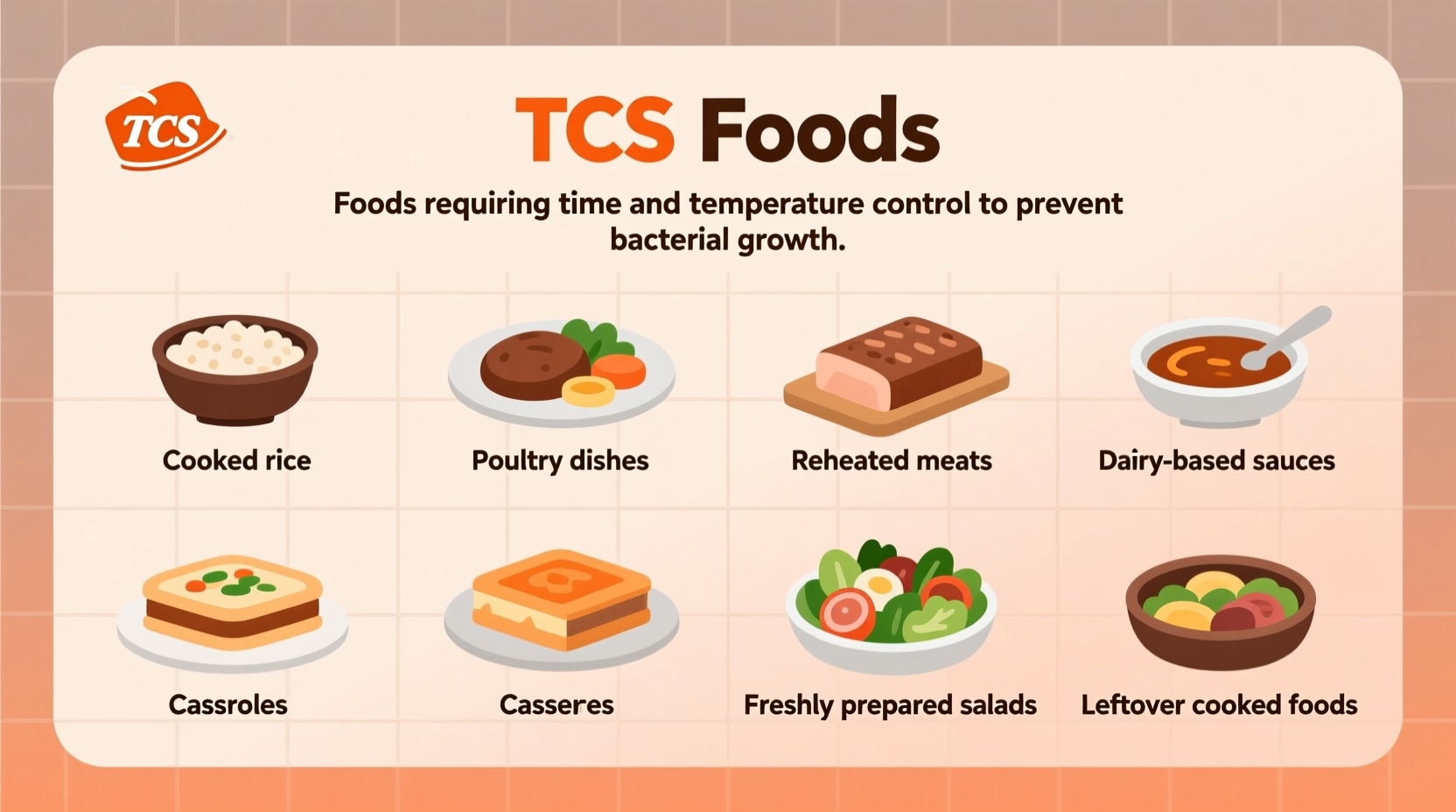Why TCS Foods Matter for Your Health and Safety
Understanding TCS foods isn't just kitchen protocol—it's your first line of defense against foodborne illness. When improperly handled, these foods create ideal breeding grounds for pathogens like Salmonella, E. coli, and Listeria that cause over 9 million foodborne illnesses annually in the United States alone. The Centers for Disease Control and Prevention (CDC) reports that improper temperature control accounts for 27% of food handling violations in commercial kitchens—mistakes that can have serious health consequences.

Complete Breakdown of the 9 TCS Food Categories
Based on the current FDA Food Code, these nine food categories require time and temperature controls to prevent pathogen growth. Recognizing these helps you implement proper food safety practices whether you're running a restaurant or preparing meals at home.
| TCS Food Category | Common Examples | Special Handling Requirements |
|---|---|---|
| Meat and Poultry | Ground beef, chicken, pork, turkey | Cook to minimum internal temperatures (160°F for ground meats, 165°F for poultry) |
| Dairy Products | Milk, soft cheeses, sour cream, yogurt | Keep refrigerated below 40°F; discard if left in danger zone over 4 hours |
| Eggs and Egg Products | Raw eggs, liquid eggs, quiches | Cook until yolks are firm; avoid room temperature storage |
| Seafood | Fish, shellfish, sushi, ceviche | Keep at 41°F or below; cook to 145°F internal temperature |
| Cut Tomatoes, Leafy Greens, and Melons | Sliced watermelon, cut lettuce, diced tomatoes | Refrigerate immediately after cutting; use within 7 days |
| Raw Seed Sprouts | Alfalfa, clover, radish sprouts | High-risk for Salmonella and E. coli; vulnerable populations should avoid raw |
| Baked Potatoes | Whole baked potatoes, especially when wrapped in foil | Cool rapidly after baking; don't hold at room temperature |
| Cooked Starchy Foods | Cooked rice, pasta, beans | Cool quickly; refrigerate within 2 hours; reheat to 165°F |
| Garlic-in-Oil Mixtures | Homemade pesto, garlic oil infusions | Refrigerate immediately; consume within 4 days; risk of botulism |
The Science Behind TCS Food Classification
The temperature danger zone (40°F-140°F or 4°C-60°C) represents the range where bacteria multiply most rapidly—doubling in number every 20 minutes under ideal conditions. The FDA's 2-hour/4-hour rule provides clear guidance: TCS foods can remain in the danger zone for up to 2 hours before requiring immediate consumption or proper refrigeration. Beyond 4 hours, these foods should be discarded due to potentially dangerous bacterial levels.
How TCS Food Guidelines Have Evolved
Food safety protocols for TCS foods have significantly advanced over the past three decades. Understanding this evolution helps contextualize current best practices:
| Time Period | Key Developments | Impact on Food Safety |
|---|---|---|
| 1990s | Introduction of HACCP principles in commercial kitchens | First systematic approach to identifying critical control points for TCS foods |
| 2001 | FDA Food Code formally defines "Potentially Hazardous Foods" (PHF) | Standardized terminology and requirements across jurisdictions |
| 2013 | "Potentially Hazardous Foods" renamed to "Time/Temperature Control for Safety Foods" | More accurate description emphasizing the critical control measures needed |
| 2022 | Updated FDA Food Code clarifies cut produce requirements | Specific guidelines for melons, tomatoes, and leafy greens added to TCS list |
Common Misconceptions About TCS Foods
Several persistent myths can lead to dangerous food handling practices. Let's clarify these critical points:
- "If it looks and smells fine, it's safe to eat" - Pathogenic bacteria often don't affect appearance, smell, or taste. The USDA confirms that sensory evaluation cannot reliably detect dangerous bacteria levels.
- "One-time temperature abuse isn't problematic" - Even brief exposure to the danger zone allows exponential bacterial growth. The FDA reports that just 2 hours in the danger zone can increase bacteria to unsafe levels.
- "Home kitchens don't need to follow TCS guidelines" - Foodborne illness doesn't discriminate between commercial and home settings. CDC data shows 80% of food poisoning cases originate in home kitchens.
Practical TCS Food Handling for Home Kitchens
While commercial kitchens follow strict protocols, home cooks can implement these evidence-based practices:
- Temperature monitoring - Use a calibrated food thermometer for all TCS foods, not just meats. Dairy products and cooked starches also require temperature verification.
- Strategic cooling - Divide large quantities of cooked TCS foods into shallow containers (no deeper than 2 inches) to cool from 140°F to 70°F within 2 hours, then to 40°F within an additional 4 hours.
- Labeling system - Implement a simple labeling approach for refrigerated TCS foods: include preparation date and "use by" date based on FDA guidelines.
- Cross-contamination prevention - Use separate cutting boards and utensils for different TCS food categories, especially when handling raw meats and ready-to-eat items like cut fruits.
Special Considerations for High-Risk Populations
Certain groups require additional precautions with TCS foods. Pregnant women, older adults, young children, and immunocompromised individuals face significantly higher risks from foodborne pathogens. For these populations:
- Avoid all raw or undercooked TCS foods including eggs, meat, and seafood
- Reduce maximum refrigeration time for TCS foods by 50% (e.g., consume cooked rice within 3-4 days instead of 7)
- Use pasteurized versions of high-risk TCS foods like dairy products and juices
- When in doubt about a TCS food's safety history, discard it rather than risk illness
Essential TCS Food Safety Resources
Stay current with the latest food safety guidelines through these authoritative sources:
- FDA Food Code 2022 - The definitive resource for TCS food requirements
- CDC Time-Temperature Guide - Visual reference for safe food handling
- USDA Food Safety and Inspection Service - Practical home food safety information











 浙公网安备
33010002000092号
浙公网安备
33010002000092号 浙B2-20120091-4
浙B2-20120091-4